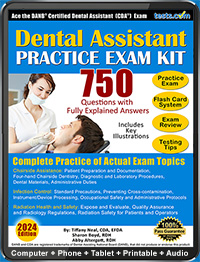2024 Edition
Practice Test for the DANB Dental Assistant Exam
Quality starts with who wrote the material.
Our practice exam writer
s
:
Tiffany Neal, CDA (DANB), EFDA
Sharon Boyd, RDH
Abby Altergott, RDH
Sharon Boyd, RDH
Abby Altergott, RDH
Our practice exam follows the CDA blueprint component exam areas: GC, RHS & ICE:
1. General Chairside Assisting (GC)
GC Exam Blueprint:
- Evaluation
- Patient Managemnt and Administration
- Chairside Dentistry
- Dental Materials
GC Exam Summary:
- 95 multiple-choice questions
- 75 minutes testing time
2. Radiation Health and Safety (RHS)
RHS Exam Blueprint:
- Purpose and Technique
- Radiation Safety
- Infection Control
RHS Exam Summary:
- 80 multiple-choice questions
- 1 hour testing time
3. Infection Control (ICE)
ICE Exam Blueprint:
- Prevent of Disease Transmission
- Prevention of Cross-contamination
- Process of Instruments and Devices
- Occupational Safety and Admin Protocols
ICE Exam Summary:
- 80 multiple-choice questions
- 1 hour testing time




